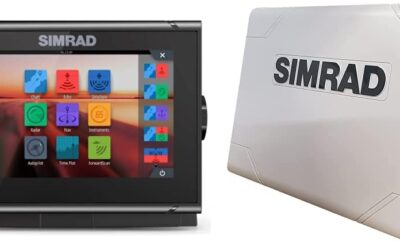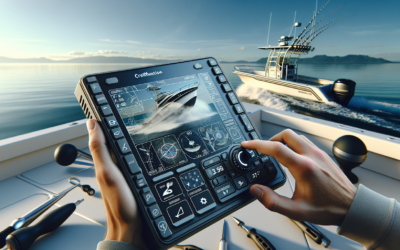Every fisherman knows that a fish finder is a crucial piece of equipment. This article will guide you through the steps to protect this vital tool from the harsh effects of the elements. “Weatherproofing your Equipment: Protecting Your Fish Finder from the Elements” offers effective solutions to ensure your fish finder lasts longer and performs to its full potential. It’s like giving your precious gear a suit of armor to guard against rain, sleet, heat, or whatever Mother Nature decides to throw at it. So why not ensure your fish finder’s longevity and efficiency by learning some useful weatherproofing skills?
Understanding the Importance of Protecting Your Fish Finder
As an angler, your fish finder is a critical tool that aids in locating fish underwater. However, due to environmental factors, this essential gear is always at risk. Understanding the importance of protecting your fish finder not only ensures it lasts longer but also maintains its efficiency.
Potential impacts of environmental elements on fish finders
Environmental elements can exercise a host of damaging effects on fish finders, ranging from physical damage to compromised functionality. This can be frustrating, especially when you’re out fishing and cannot get an accurate reading because the screen is too dim from sunlight exposure or the buttons are malfunctioning due to moisture.
Cost-effectiveness of weatherproofing vs. replacing equipment
When you consider the high cost of replacing a fish finder, weatherproofing becomes a much more budget-friendly solution. With the right protective practices and maintenance, you can significantly extend the life of your equipment, thus preserving your investment.
Identifying Vulnerable Components of a Fish Finder
Before you can embark on protecting your fish finder, it is vital to recognize its vulnerable components.
Crucial electronic components of fish finders
The most susceptible parts of a fish finder are the electronic components such as the screen, transducers, and buttons. These parts are sensitive to elements like moisture and direct sunlight and are thus more prone to damage.
Material weaknesses and potential issues that come with exposure
Fish finders are usually cased in plastic or metal, materials that can degrade and weaken over time due to constant exposure to elements like water, heat, and UV rays. Damage can also come from saltwater, which is particularly corrosive to metal parts.
Effects of Various Weather Conditions
Various weather conditions can affect the functionality and durability of your fish finder.
How constant exposure to sunlight affects fish finders
Direct sunlight can cause the color on your fish finder’s screen to fade. Additionally, constant exposure to UV rays can degrade the casing material, leading to cracks and leaks.
Damage caused by moisture from rain or sea spray
Moisture from rain, fog, or sea spray can penetrate your fish finder, especially via openings or unsealed connections. It can cause short circuits and corrosion of electronic components.
The impact of cold weather and freezing temperatures
Cold weather and freezing temperatures can damage the LCD screen of your fish finder. When exposed to freezing temperatures, the display can become sluggish or completely unresponsive.
Basic Weatherproofing Tips and Techniques
There are several basic tips and techniques you can apply to weatherproof your fish finder.
Keeping the fish finder clean
Keeping your fish finder clean can help prevent long-term damage. After each use, wipe it down with a soft cloth to remove water, dirt, and salt residues.
Regular inspection for signs of wear and tear
Regularly inspect your fish finder for signs of wear. Check for any cracks, discoloration, or deterioration in the casing. Pay particular attention to the screen and seals.
The correct way to store your equipment
How you store your fish finder plays a significant role in its longevity. Aim to store your equipment in a cool, dry area away from direct sunlight.
Using Protective Covers
Equipping your fish finder with a protective cover can offer additional safety from the elements.
Purpose and benefits of using protective covers
Protective covers work to shield your device from harmful elements such as UV rays, dust, and moisture. They also protect from physical damage like scratches or impact damages.
How to choose the right size and material
Ensure the cover you choose fits your fish finder correctly and is made from durable, water-resistant materials such as vinyl or polyester.
Using protective covers effectively and efficiently
Always use the protective cover when the fish finder is not in use. Ensure it is securely fitted and removed with care to avoid any possible damage to the device.
Applying Weatherproofing Coatings
Applying a weatherproofing coating can add an extra layer of protection against the elements.
The benefits of using weatherproofing coatings
Weatherproofing coatings can shield your fish finder against both UV rays and water damage. They can also prevent corrosion, extend the lifespan of your device, and maintain its aesthetic appeal.
Types of coatings and their applications
Coatings come in various types, including polyurethane and silicone-based. They are easy to apply, usually requiring a simple brush-on application.
Step-by-step guide to applying coatings
Before applying the coating, ensure your fish finder is clean and dry. Apply the coating evenly, paying close attention to areas prone to wear like corners and seams.
Sealing Openings and Connections
Sealing openings and connections is a critical factor in preventing water and moisture ingress.
Potential problems with unsealed openings
Unsealed openings allow water and moisture to infiltrate your device, leading to short circuits and eventual malfunction.
Sealing techniques and tools
Use quality sealing materials like marine-grade silicone sealants. Apply them around the openings and connections, ensuring they are fully covered.
Maintaining the effectiveness of seals over time
Regular inspection and maintenance of the seals are necessary. Check for any leaks or wear, and reapply sealant as needed.
Opting for Waterproof Models
If you often fish in severe weather conditions, considering a waterproof fish finder may be beneficial.
Understanding the benefits of investing in waterproof models
Waterproof models come equipped with higher resistance to water and moisture, providing peace of mind even in rough weather conditions.
Things to consider when choosing a waterproof fish finder
Factors to consider include the degree of waterproofing, durability, functionality, and the cost.
Price comparison between standard and weatherproof models
While waterproof models might cost more upfront, they often offer a better ROI given their extended lifespan and reduced maintenance needs.
Maintenance and Care Techniques
Regular maintenance and care are essential, irrespective of the weatherproofing measures employed.
Regular cleaning: when and how often?
Regular cleaning after each use is recommended. A thorough cleaning and inspection are advised every few weeks, depending on the frequency of usage.
The importance of keeping firmware updated
Keeping the firmware updated ensures smooth operation and usability. Manufacturers often release updates to fix bugs, enhance performance, or add new features.
Recommended servicing processes
For professional check-ups, servicing your fish finder at least once a year with a skilled technician can help extend its lifespan.
Professional Weatherproofing Services
If DIY methods are not your cup of tea or if you require more thorough weatherproofing, professional services are available.
Pros and cons of professional services
Professional services provide comprehensive weatherproofing solutions, taking care of every minor detail. However, they can be expensive, and you’ll need to hand over your valuable equipment to a third party.
What to expect from weatherproofing service providers
A professional service provider will comprehensively assess and treat your fish finder to ensure optimal weather resistance. The process may include cleaning, inspection, sealing, applying weatherproofing coatings, and potentially replacing damaged elements.
Choosing a reliable and reasonably priced service
When selecting a professional service provider, consider factors like cost, reputation, and customer reviews. Check if they specialize in fishing equipment and ensure that they offer a warranty for their work.
In conclusion, by understanding the importance of protecting your fish finder and implementing various protective strategies, you’ll prolong the life of your equipment, ensuring better performance while saving substantial replacement costs.









